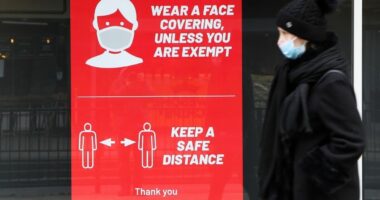Share this @internewscast.com
Record numbers of patients are making their own way to A&E without waiting for an ambulance, a study suggests.
Long response times and scenes of emergency vehicles queuing outside hospitals are thought to have fuelled the surge in people turning to alternative transport – even in the most urgent cases.
NHS England data shows 19.5million attendances (79 per cent) were from people who walked, cycled or used public transport, a taxi or a private vehicle in 2023/24.
Now new analysis from a subset of 30 NHS trusts indicate a growing proportion were the sickest patients.
They recorded 2.7million non-ambulance A&E arrivals in 2024 – up 340,000 or 14 per cent since 2019.
Of these, 266,460 patients were assigned the most severe category one or two ratings on arrival, meaning they were in need of ‘immediate’ or ‘very urgent’ medical attention – a rise of 50 per cent over the same period.
Helen Morgan, health and social care spokesperson for the Liberal Democrats, who obtained the new data under Freedom of Information laws, said: ‘These figures lay bare an Uber ambulance crisis, where people do not think they can rely on ambulance services even in the most serious of circumstances.
‘This could have deadly consequences if people have lost faith that ambulances will be there when they need them.’

Data shows 19.5million attendances (79 per cent) were from people who walked, cycled or used public transport, a taxi or a private vehicle
In 2022, Dr Katherine Henderson, the then president of the Royal College of Emergency Medicine, admitted she would consider calling a taxi or giving a loved one a lift to hospital, rather than call an ambulance as she was ‘worried’ one would not arrive on time.
Dennis Reed, director of Silver Voices, which campaigns for elderly Britons, said: ‘Older people have lost all confidence that if they need an ambulance they will get one in time so will often resort to DIY solutions.
‘A blue light ambulance used to be the quickest way to get to hospital but this is increasingly not true.
‘If you live 30 minutes drive from hospital but the ambulance will take an hour to get to you then it becomes a no brainer.
‘The solution is not so much not enough ambulances – as many are waiting outside hospitals because of a lack of beds.
‘The solution is for the Government to stop ignoring the social care crisis.’
The latest official figures show the average response time for the most life-threatening 999 calls was 7 minutes 56 seconds in July, although one in ten callers waited more than 14 minutes 12 seconds.
The average target of 7 minutes has not been met for four years.

A growing proportion of those not travelling by ambulance were the sickest patients
The average response time for category two calls, which includes heart attacks and strokes, was 28 minutes 40 seconds and the average for category three calls, including severe pain, was 1 hour 40 minutes.
The Trust that saw the largest rise in non-ambulance A&E attendances, according to the subset of Freedom of Information responses, was Sandwell and West Birmingham, where there was a 320 per cent rise since 2019, with the figures jumping from 3,900 to 16,500.
Mid and South Essex had the highest number of attendances not arriving in an ambulance last year at 322,000, up from 263,000 over the same period.
The Liberal Democrats also asked for figures non-ambulance A&E arrivals by those aged over 65.
Last year, there were 459,000, up 22 per cent on 2019’s 375,000 according to the 22 NHS Trusts which responded with full data. Of these,56,700 were rated Code 1 or Code 2.
The steepest rise in over 65s non-ambulance attendances was in North Cumbria where they jumped 97 per cent to 22,305.
The Liberal Democrats want the Government to create a new £50 million-a-year emergency fund to allow ambulance trusts to reverse closures of community ambulance stations and to launch a campaign to retain, recruit and train paramedics and other ambulance staff.
Ms Morgan added: ‘We are still seeing people being treated in A&E corridors and ambulances queuing up outside, causing delays that people are rightfully terrified by.

Helen Morgan, health and social care spokesperson for the Liberal Democrats, Uber ambulance crisis
‘Everyone should call and wait for an ambulance if they need one, but we also have to also make sure they reach people on time so no one thinks they have to take themselves to A&E in a life and death situation.
‘That means protecting local ambulance stations from closure and launching a campaign to retain, recruit and train paramedics and other ambulance staff.’
Daniel Elkeles, chief executive of NHS Providers and former chief executive of London Ambulance Service, said: ‘There may be lots of reasons why people chose to go to hospital themselves rather than call 999. The NHS is there for anyone in an emergency.
‘Latest official figures show that ambulances are getting to people more quickly despite high demand, with staff attending more than 650,000 incidents and answering more than 843,500 calls to 999 in a month.
‘Meanwhile, despite 2.4million A&E attendances – the busiest July on record – the highest proportion of patients in almost four years were seen within four hours. NHS trusts and staff work flat out to see patients as quickly as possible.’
Anna Parry, managing director of the Association of Ambulance Chief Executives, said: ‘Data proves that NHS ambulance services have never been busier answering 999 calls and responding to more patients than ever before, something that is testament to our incredibly hard-working frontline staff, as well as those handling the calls and dispatching the most appropriate clinical response to patients in need.
‘The NHS and its individual ambulance services continue to invest in the development and training of paramedics and other clinical staff, in order to manage the increase in demand for our services and provide high quality care in as timely manner as we are able.’
A Department of Health and Social Care spokesperson said: ‘We inherited an emergency care system on its knees, with patients left facing lengthy waits for ambulances and often even longer handover delays when they reached hospital.
‘Despite record A&E demand, we are turning things around, with ambulances getting to patients faster in July than the same time last year, and handover delays also coming down.
‘Our £450 million investment in urgent and emergency care services includes new ambulances, to make sure the NHS can be there for all of us on time when we need it.’
















